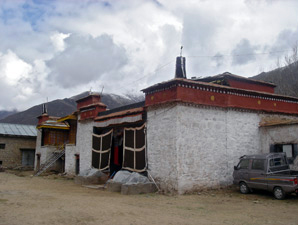


The complete name of this monastery is Drikung Yangar Thubten Dezhi Rabgyeling (‘bri gung yang sgar thub bstan sde bzhi rab rgyas gling). It was located 10 kilometers up the Shorongchu, a tributary of the Kyichu river to the east of Lhasa. At this place the river ran in quite a deep gorge near the monastery. Yangrigar stood in the valley at the base of a scarp on the left bank of the river. The monastery was built in the 17th century by Thrinle Sangpo (1656-1718), the 2nd Chetsang Rinpoche. There actually was a small monastery at this place in earlier times, which was severely damaged during battles with Mongol troops. Eventually Thrinle Sangpo constructed a spacious new monastery there in 1681. Besides Drikung Thil it was considered the most important and largest of the Drikung monasteries.
The 6th Chetsang Tenzin Shiwe Lodro (1886–1943) arranged for the renovation of Yangrigar and the addition of a building for storing the wooden blocks used for printing Buddhist texts.
Cultivated fields surrounded the monastery and there were several old stupas outside the compound. The massive, five floors high red painted main temple (lha khang chen po) of Yangrigar was topped by a band of white masonry. It was entered past a line of stupas through a gateway in the west side of a white wall which surrounded the whole monastery and where the monks’ cells and storerooms were located. On top of the high central building the residences of the Chetsang and Chungtsang Rinpoches were situated. It also included the quarters of the manager (phyag mdzod) of the Labrang (the estate of a Tulku). A broad white tower to the south was used for the display of large ceremonial religious banners (gos sku).
Fine life-size statues of all the lineage holders from Vajradhara (rdo rje ‘chang) to the 6th Chetsang Shiwe Lodro lined the walls of the Temple of the Throne Holders (gdan rabs khang). Another much revered figure in this shrine room was a “speaking image” (gsung byon ma) of Chenrezig made by the 3rd Chungtsang Chokyi Nyima (1755-1792). In the large assembly hall with its 48 pillars were tall statues of Maitreya, Chenrezig and Buddha Shakyamuni. The Achi treasure room housed a great variety of precious offering objects, among those a series of thangkas painted mainly in gold (gser thang), which were brought out from the Achi treasury only every twelve years during the Drikung Phowa Chenmo. Several enormous silk brocade thangkas were displayed once a year outside the front elevation of the monastery.

Before the destruction of the monastery, 500 monks were residing in the compound. In 1960 the entire structure was torn down in order to build a Chinese military base. For fifteen years only one wall of a temple remained standing. After a series of deaths amongst those engaged in the destruction no one dared to ruin the wall. Legend has it that the Drikung protectress Achi would reside inside this wall and anyone tampering with the goddess’ residence would die soon. Only in 1985 this last remaining structure of Yangrigar Monastery was demolished.
In the vicinity of the old monastery recently a new Yangrigar Monastery was erected, but compared to the splendor of the original building it is only a distant echo. The Yangrigar Monastery still owns a large piece of land, but financial means are still lacking in order to rebuild a large monastery there. The monastery of Yamari (g.ya’ ma ri dgon) in the vicinity has not been restored, but is still active and the monks of Yangrigar and Yamari help each other in their efforts of refurbishment and education. Presently there are about 100 monks residing in both the monasteries.

